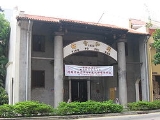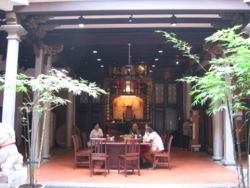
Ying Fo Fui Kun
Encyclopedia

Hakka people
The Hakka , sometimes Hakka Han, are Han Chinese who speak the Hakka language and have links to the provincial areas of Guangdong, Jiangxi, Guangxi, Sichuan, Hunan and Fujian in China....
clan
Clan
A clan is a group of people united by actual or perceived kinship and descent. Even if lineage details are unknown, clan members may be organized around a founding member or apical ancestor. The kinship-based bonds may be symbolical, whereby the clan shares a "stipulated" common ancestor that is a...
association
Voluntary association
A voluntary association or union is a group of individuals who enter into an agreement as volunteers to form a body to accomplish a purpose.Strictly speaking, in many jurisdictions no formalities are necessary to start an association...
in Singapore
Singapore
Singapore , officially the Republic of Singapore, is a Southeast Asian city-state off the southern tip of the Malay Peninsula, north of the equator. An island country made up of 63 islands, it is separated from Malaysia by the Straits of Johor to its north and from Indonesia's Riau Islands by the...
. Its clan house is located at Telok Ayer Street in the Outram Planning Area
Outram, Singapore
Outram is a district in Singapore, within the Central Area, relatively near the prominent city centre and financial districts, but is nearer the border of the Central Area, and outside the Downtown Core. Outram is served by extensive public transport, including SBS Transit and a Mass Rapid Transit ...
, within the Central Area
Central Area
In Singapore, the Central Area or Central Business District contains the core financial and commercial districts, including eleven urban planning areas, namely Downtown Core, Marina East, Marina South, Museum, Newton, Orchard, Outram, River Valley, Rochor, Singapore River and Straits View as...
, Singapore's central business district
Central business district
A central business district is the commercial and often geographic heart of a city. In North America this part of a city is commonly referred to as "downtown" or "city center"...
.
The Ying Fo Fui Kun clan house building was constructed in 1881-1882. Ying Fo Fui Kun was the first Hakka association in Singapore and once housed the Ying Sin School (應新學校) from 1905 to 1971.
History
Established in 1822-1823, Ying Fo Fui Kun is the oldest clan associations in Singapore. At a time when development in Singapore was in its infancy, Ying Fo Fui Kun's clan house was amongst the first buildings in Telok AyerTelok Ayer
Telok Ayer is a historic district located in Singapore's Chinatown within the Central Business District, straddling the Outram Planning Area and the Downtown Core under the Urban Redevelopment Authority's urban planning zones.-Etymology:...
, where the island's earliest Chinese
Chinese people
The term Chinese people may refer to any of the following:*People with Han Chinese ethnicity ....
settlement
Urban-type settlement
Urban-type settlement ; , selyshche mis'koho typu ) is an official designation for a type of locality used in some of the countries of the former Soviet Union...
s were located.
Ying Fo Fui Kun began life as a temple
Temple
A temple is a structure reserved for religious or spiritual activities, such as prayer and sacrifice, or analogous rites. A templum constituted a sacred precinct as defined by a priest, or augur. It has the same root as the word "template," a plan in preparation of the building that was marked out...
, serving the needs of Hakka immigrants from Jia Ying prefecture
Prefecture
A prefecture is an administrative jurisdiction or subdivision in any of various countries and within some international church structures, and in antiquity a Roman district governed by an appointed prefect.-Antiquity:...
in Canton
Guangzhou
Guangzhou , known historically as Canton or Kwangchow, is the capital and largest city of the Guangdong province in the People's Republic of China. Located in southern China on the Pearl River, about north-northwest of Hong Kong, Guangzhou is a key national transportation hub and trading port...
. Its founder
Entrepreneur
An entrepreneur is an owner or manager of a business enterprise who makes money through risk and initiative.The term was originally a loanword from French and was first defined by the Irish-French economist Richard Cantillon. Entrepreneur in English is a term applied to a person who is willing to...
, Liu Runde (劉潤德), envisaged Ying Fo Fui Kun as a public institution that would not only provide welfare services — the conventional role of a clan association — but also act as a kinship
Kinship
Kinship is a relationship between any entities that share a genealogical origin, through either biological, cultural, or historical descent. And descent groups, lineages, etc. are treated in their own subsections....
bridge between the Hakka community in Singapore and China
China
Chinese civilization may refer to:* China for more general discussion of the country.* Chinese culture* Greater China, the transnational community of ethnic Chinese.* History of China* Sinosphere, the area historically affected by Chinese culture...
. Ying Fo Fui Kun looked after the welfare of its members, finding accommodation
Lodging
Lodging is a type of residential accommodation. People who travel and stay away from home for more than a day need lodging for sleep, rest, safety, shelter from cold temperatures or rain, storage of luggage and access to common household functions.Lodgings may be self catering in which case no...
and jobs for newly-arrived Hakkas and making funeral
Funeral
A funeral is a ceremony for celebrating, sanctifying, or remembering the life of a person who has died. Funerary customs comprise the complex of beliefs and practices used by a culture to remember the dead, from interment itself, to various monuments, prayers, and rituals undertaken in their honor...
arrangements for deceased clan members. In 1905, Ying Fo Fui Kun opened what was then considered a modern Chinese
Chinese language
The Chinese language is a language or language family consisting of varieties which are mutually intelligible to varying degrees. Originally the indigenous languages spoken by the Han Chinese in China, it forms one of the branches of Sino-Tibetan family of languages...
school
School
A school is an institution designed for the teaching of students under the direction of teachers. Most countries have systems of formal education, which is commonly compulsory. In these systems, students progress through a series of schools...
.
Architecture

Rock (geology)
In geology, rock or stone is a naturally occurring solid aggregate of minerals and/or mineraloids.The Earth's outer solid layer, the lithosphere, is made of rock. In general rocks are of three types, namely, igneous, sedimentary, and metamorphic...
tablet
Clay tablet
In the Ancient Near East, clay tablets were used as a writing medium, especially for writing in cuneiform, throughout the Bronze Age and well into the Iron Age....
s and carved
Wood carving
Wood carving is a form of working wood by means of a cutting tool in one hand or a chisel by two hands or with one hand on a chisel and one hand on a mallet, resulting in a wooden figure or figurine, or in the sculptural ornamentation of a wooden object...
boards from the nineteenth century. The clan's oldest surviving artefact
Cultural artifact
A cultural artifact is a term used in the social sciences, particularly anthropology, ethnology, and sociology for anything created by humans which gives information about the culture of its creator and users...
is an 1846 inscribed board.
On the ground floor are meeting
Meeting
In a meeting, two or more people come together to discuss one or more topics, often in a formal setting.- Definitions :An act or process of coming together as an assembly for a common purpose....
and administration rooms, while the upper level houses an altar
Altar
An altar is any structure upon which offerings such as sacrifices are made for religious purposes. Altars are usually found at shrines, and they can be located in temples, churches and other places of worship...
dedicated to Guan Ti
Guan Yu
Guan Yu was a general serving under the warlord Liu Bei during the late Eastern Han Dynasty of China. He played a significant role in the civil war that led to the collapse of the Han Dynasty and the establishment of the state of Shu Han during the Three Kingdoms period, of which Liu Bei was the...
(关帝), the god of war
War
War is a state of organized, armed, and often prolonged conflict carried on between states, nations, or other parties typified by extreme aggression, social disruption, and usually high mortality. War should be understood as an actual, intentional and widespread armed conflict between political...
. A popular deity
Deity
A deity is a recognized preternatural or supernatural immortal being, who may be thought of as holy, divine, or sacred, held in high regard, and respected by believers....
revered by many clan associations, Guan Ti embodies the qualities of courage
Courage
Courage is the ability to confront fear, pain, danger, uncertainty, or intimidation...
and loyalty
Loyalty
Loyalty is faithfulness or a devotion to a person, country, group, or cause There are many aspects to...
— two virtue
Virtue
Virtue is moral excellence. A virtue is a positive trait or quality subjectively deemed to be morally excellent and thus is valued as a foundation of principle and good moral being....
s close to the hearts of the early Chinese immigrants.
The clan building has been well preserved
Historic preservation
Historic preservation is an endeavor that seeks to preserve, conserve and protect buildings, objects, landscapes or other artifacts of historical significance...
; a 1997 renovation
Renovation
Renovation is the process of improving a structure. Two prominent types of renovations are commercial and residential.-Process:The process of a renovation, however complex, can usually be broken down into several processes...
restored
Building restoration
Building restoration describes a particular treatment approach and philosophy within the field of architectural conservation. According the U.S...
the intricate beam
Beam (structure)
A beam is a horizontal structural element that is capable of withstanding load primarily by resisting bending. The bending force induced into the material of the beam as a result of the external loads, own weight, span and external reactions to these loads is called a bending moment.- Overview...
carvings to their original splendour.
The Ying Fo Fui Kun clan house was gazetted as a national monument
National Monuments of Singapore
National Monuments of Singapore are buildings and structures in Singapore that have been designated by the Preservation of Monuments Board as being of special historic, traditional, archaeological, architectural or artistic value....
on 18 December 1998.

